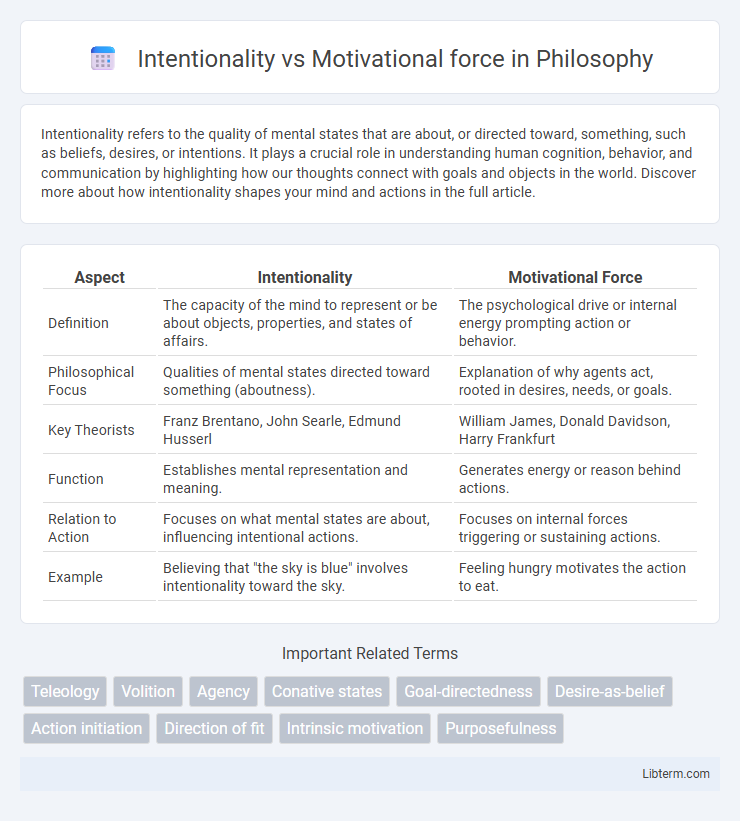Intentionality refers to the quality of mental states that are about, or directed toward, something, such as beliefs, desires, or intentions. It plays a crucial role in understanding human cognition, behavior, and communication by highlighting how our thoughts connect with goals and objects in the world. Discover more about how intentionality shapes your mind and actions in the full article.
Table of Comparison
| Aspect | Intentionality | Motivational Force |
|---|---|---|
| Definition | The capacity of the mind to represent or be about objects, properties, and states of affairs. | The psychological drive or internal energy prompting action or behavior. |
| Philosophical Focus | Qualities of mental states directed toward something (aboutness). | Explanation of why agents act, rooted in desires, needs, or goals. |
| Key Theorists | Franz Brentano, John Searle, Edmund Husserl | William James, Donald Davidson, Harry Frankfurt |
| Function | Establishes mental representation and meaning. | Generates energy or reason behind actions. |
| Relation to Action | Focuses on what mental states are about, influencing intentional actions. | Focuses on internal forces triggering or sustaining actions. |
| Example | Believing that "the sky is blue" involves intentionality toward the sky. | Feeling hungry motivates the action to eat. |
Understanding Intentionality: Defining the Concept
Intentionality refers to the mind's capacity to represent objects, states, or events as being about something, characterized by directedness or aboutness in mental states. Unlike motivational force, which drives behavior through desires and needs, intentionality centers on the content and purpose behind thoughts or actions. Understanding intentionality involves recognizing its role in linking mental phenomena to their intentional objects, emphasizing the semantic aspect of mental representation.
What is Motivational Force? Core Principles
Motivational force refers to the internal drive or energy that compels an individual to take action toward achieving goals or fulfilling needs. Core principles include intrinsic motivation, which originates from personal satisfaction, and extrinsic motivation, driven by external rewards or pressures. This force operates through a combination of desires, beliefs, and expectations, shaping behavior and decision-making processes.
Key Differences Between Intentionality and Motivation
Intentionality refers to the deliberate and purposeful direction of mental states toward specific objects or goals, highlighting cognitive commitment, while motivational force involves the internal drive or energy that compels behavior toward achieving those goals. Intentionality emphasizes the representational content and directedness of thoughts, whereas motivation focuses on the psychological and physiological mechanisms that energize and sustain actions. Key differences include intentionality's role in goal formation and mental representation contrasted with motivation's function in behavioral activation and persistence.
The Interplay: How Intentionality Shapes Motivation
Intentionality shapes motivation by providing clear goals that direct and sustain effort toward desired outcomes. The presence of intentionality enhances motivational force by aligning actions with personal values and purpose, increasing persistence and focus. Understanding this interplay reveals how deliberate intentions act as catalysts, transforming abstract desires into concrete, goal-driven behaviors.
Psychological Theories on Intent and Motivation
Psychological theories distinguish intentionality as the purposeful direction of mental states aimed at specific goals, while motivational force refers to the underlying drives that energize and sustain behavior. Intentionality is central in cognitive theories emphasizing goal-setting and planning, whereas motivational force is key in frameworks like self-determination theory, which highlights intrinsic and extrinsic motivations. Research by psychologists such as Bratman and Deci underscores that understanding how intent shapes action requires examining both the conscious commitment to goals and the motivational dynamics that fuel persistence.
Real-World Examples: Intentionality vs Motivational Force
Intentionality involves deliberate mental states guiding an individual's actions, such as a student studying to pass an exam, reflecting purposeful planning. Motivational force drives behavior through internal desires or needs, exemplified by hunger prompting someone to seek food without conscious intent. Differentiating these concepts clarifies how goal-oriented intentions differ from underlying motivational energy influencing real-world behaviors.
Measuring Intentionality and Motivation
Measuring intentionality involves assessing goal-directed behavior and cognitive commitment through tasks that evaluate decision-making, planning, and awareness of actions. Motivation is quantified using scales that gauge drive strength, persistence, and reward sensitivity, often employing self-reports and physiological indicators like heart rate variability. Combining behavioral metrics with neuroimaging techniques provides a comprehensive analysis of how intentionality and motivational force influence human actions.
Enhancing Productivity: The Role of Intentional Action
Intentional action drives productivity by focusing effort on specific goals, ensuring that tasks align with core objectives and minimizing distractions. Unlike motivational force, which fluctuates based on emotions or external stimuli, intentionality provides a consistent framework for decision-making and prioritization. Harnessing intentionality enables individuals to create structured workflows and maintain sustained progress towards desired outcomes.
Why Motivation Alone Isn’t Enough
Motivation alone often fails to sustain long-term achievement because it lacks the structured framework intentionality provides, which connects goals with concrete plans and purposeful actions. Intentionality drives focused effort by aligning behavior with clear objectives, ensuring consistent progress beyond fleeting motivational spikes. The integration of both motivational force and intentionality creates a resilient foundation for enduring success and meaningful outcomes.
Cultivating Intentionality for Sustainable Success
Cultivating intentionality involves deliberate goal-setting and mindful decision-making to align actions with core values, which enhances clarity and focus. Sustainable success relies on this purposeful approach rather than reactive motivation, ensuring consistent progress despite challenges. Developing intentional habits fosters resilience and long-term commitment, driving meaningful and lasting achievements.
Intentionality Infographic

 libterm.com
libterm.com